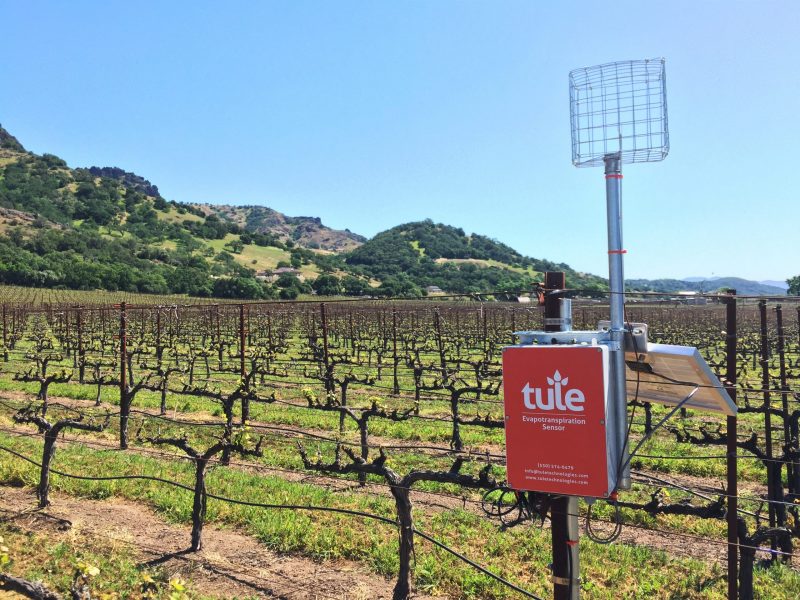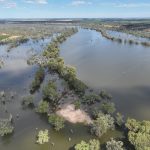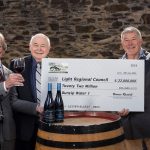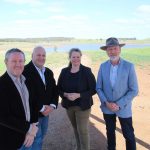Learnings from an AgTech road trip across California
With water security and dry conditions pressing issues for winegrape growers in both Australia and on the US west coast, Oli Madgett recently visited the Golden State where innovation is helping to tackle the challenges surrounding restrictive water usage and broader sustainability. He offers a comparison of the vineyard equipment, technology and methods used on both sides of the Pacific.
The Great Wine Capitals Network gave me the opportunity to swap my usual surrounds of McLaren Vale and Adelaide with Napa and San Francisco, with the intention to learn about the challenges that growers are facing over there, and the solutions that are being created to solve them in the high tech Mecca of the world.
Taking off through the smoke haze at Sydney airport, leaving a country gripped by a debilitating drought, squabbling over the unsustainably stretched water resources that breathe life into an otherwise desert, meant that landing in California practically felt like home-from-home!
I remember the outcry from the state-wide power outages in South Australia that led to Elon coming to the rescue with his giant Tesla battery, but the same thing is happening on his own doorstep…
Wildfires, often started by ageing power lines, have ravaged regions like Sonoma and Napa, leading to a recent mass evacuation of over 180,000 people, and this has resulted in the current situation of arriving in Napa to find that they’re turning off the power for three days!
A change in the status quo is often one of the biggest drivers of innovation and for vineyards and wineries, it’s meant a scramble to install back-up generators and working on tech solutions to track the location of all their workers in case of any emergencies.
Water security a pressing concern
There hadn’t been any significant rain events in the previous six months and long-term water security is a pressing concern that we share across both wine capitals.
Grapegrowing in California has relied heavily on ground water, with limited restrictions on usage and this has resulted in significant over extraction to date, with cities such as Fresno sinking by over half a metre as a result.
Some farmers simply want to ‘dig a deeper well’ and ‘Make California Green Again’, but change is coming this year, in the form of the Sustainable Groundwater Management Act (SGMA), with a 20-year timeline to achieve long-term water sustainability.
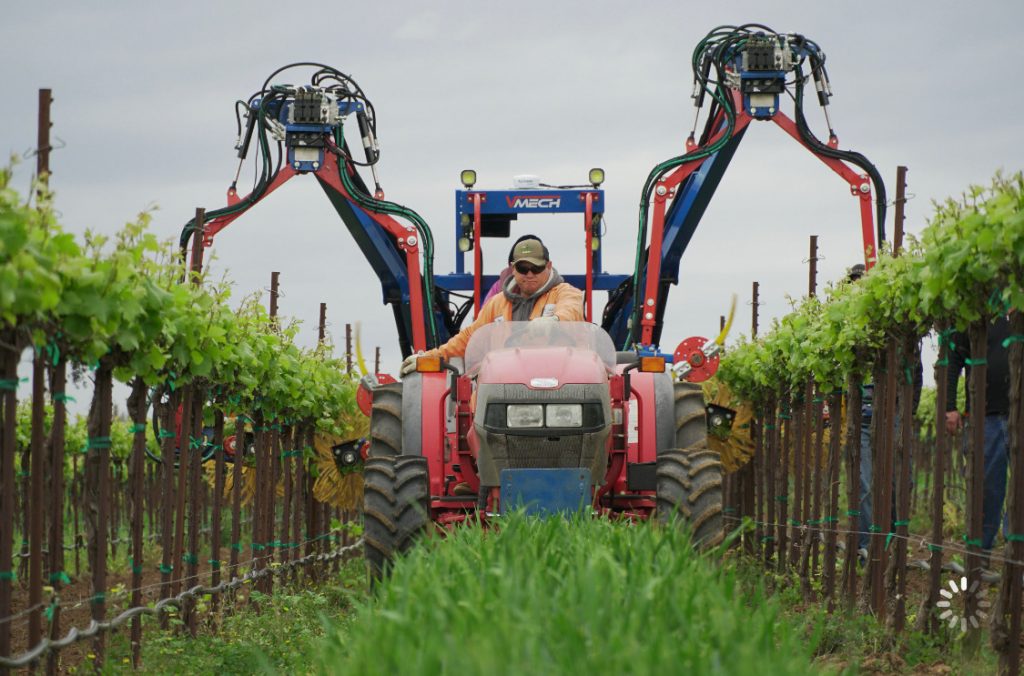
And with change comes opportunities, and a flood of well-funded tech companies have come into the space.
Many of the start-ups are based in the Water, Energy and Technology Centre, and some of the most interesting include:
- Water Bit (waterbit.com) a well-funded (US$11.4m) end-to-end smart irrigation solution, that’s had positive traction with growers.
- BioFiltro (biofiltro.com/en/) whose filtration system uses worms and microbes to remove contaminants from winery wastewater and produces natural fertilisers to put back out on the vineyard, with Fetzer Vineyards being an early adopted.
- PowWow (powwow.io) who are using the remote monitoring of energy consumption of pumps as an accurate and cost effective proxy for measuring water usage.
- Tule (tuletechnologies.com) who’s well-regarded technology is measuring real time actual evapotranspiration across whole vineyard blocks, rather that providing a point solution based on only a single location.
- niolabs (niolabs.com) are powering the first autonomous vineyard irrigation system in the world, with their algorithmic scheduling software taking in real time data from the status of the vineyard, the current weather forecast and growers’ own insights and knowledge of each watering zone being an additional localised input. nio are using edge computing so that the intelligence and logic of the system is physically located on the vineyard and not in the cloud, increasing the system’s resilience by removing reliance on continuous internet connectivity, which is an approach that makes logical sense for Australian conditions as well.
It was great to also see that Adelaide’s own award winning Waterfind (waterfind.com.au) has set-up in California, and our popular AgWorld (www.agworld.com/au/) vineyard management platform is also getting good traction and reviews from growers over there.
The government has introduced a State Water Efficiency and Enhancement Program (SWEEP), which provides grants for on-farm irrigation improvements, but the challenges around scaling its usage has highlighted a challenge that’s also helping to hold back the adoption of AgTech solutions in Australia – namely the lack of confidence and trust that growers have around the usage of their data.
Some growers in Napa have pushed back on the opportunity as they don’t want any technology installed on their vineyards that they perceive could give the government visibility on their water usage. In Australia, concerns around data usage have often been voiced as not wanting to ‘have a Facebook’ done on them, whereby they inadvertently lose control of their data and ultimately become the product themselves.
The trip really highlighted the fact that until the tech industry engages and works with growers to create transparent open data standards that are workable for all parties, we’re going to continue to struggle on both sides of the Pacific to create a vibrant and commercially viable AgTech ecosystem that’s working collaboratively to solve the biggest challenges we’re facing.
Moving toward task automation
With the rise of Trump has come the fall in migrant labour that many vineyards had relied upon and this has been a major driver towards automation of tasks.
There’s already been a significant shift towards adopting machine harvesting and this is leading to the development of innovative implements from companies like VMECH (vmech.com) who’ve developed a 2 row tow-behind trailer that enables the operators to carry out high quality mechanised pruning and also to swap in other tools to carry out jobs such as knocking off water shoots.
The ‘Intelligent Spray System’ developed in partnership by USDA and Ohio State University is a great example of technology that’s coming out of research and being commercialised successfully through SmartApply (smartapply.com) and is seeing excellent results in terms of reducing chemical usage and spray drift, and it’d be great to hopefully see it getting adopted in the Australian market.
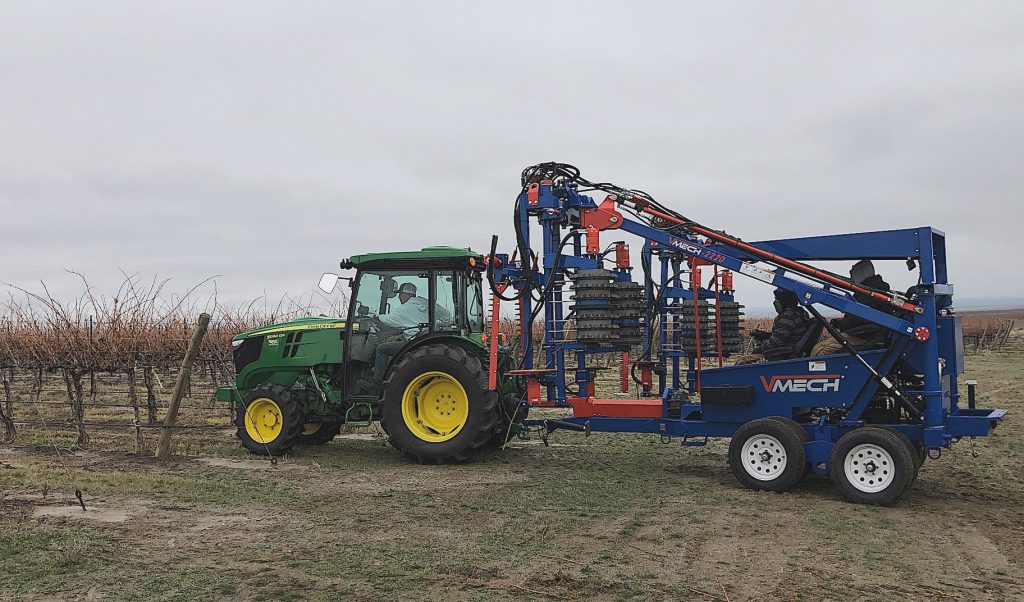
Napa is blessed with being on the doorstep of Silicon Valley, benefitting from the talent and money that’s flowing around that part of the world. The region has some of the most forward thinking, data driven, and digitally joined-up operators I’ve met in the wine industry.
One example was Will Drayton at Treasury Wine Estates, who’s bringing together a constellation of best in class AgTech companies like Arable (arable.com) that are feeding data into a central data lake.
TWE have partnered with the data scientists at trellis (trellig.ag) to identify actionable optimisation all along their supply and production chain, whether it be real time crop prediction around yield and harvest timings, helping to reduce instability and risk, leading to smarter scheduling of fruit delivery slots, or on the market intelligence side.
A downside of being next to the technology hub of the world can be that growers, contractors and viticulturists can get inundated by start-ups that are telling them how they can do things better, but often with start-ups not totally understanding the underlying problems that the industry needs to solve.
The saying that Matthew Fealy at HortRobotics has about getting the right ‘Geek to Farmer ratio’ in AgTech teams still rings true, but it is great to see tech talent starting to want to solve the critical challenges facing agriculture, rather than simply churning out the next ‘assisted living app for millennials’.
Whilst San Francisco is currently taking the lead in terms of tech innovation, it certainly felt like the wine industry around Adelaide is ahead from a sustainability perspective – led by programs such as Sustainable Winegrowing Australia and initiatives such as the EcoVineyards project.
Midrows in Napa were tilled and bare earth, without a sheep grazing in sight; compost spreading didn’t seem like a mainstream practice and I was really surprised to see that no vineyards had mulch or straw banded on them.
But I did later learn that mounding under-vine can lead to getting infested by gophers making their burrowed homes amongst your vines roots – the challenges of farming never end!
This article was originally published in the February issue of The Australian and New Zealand Grapegrower & Winemaker magazine.
